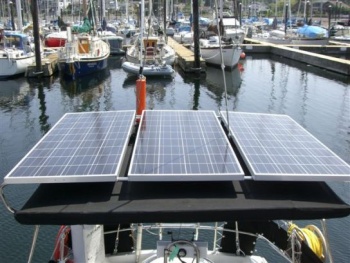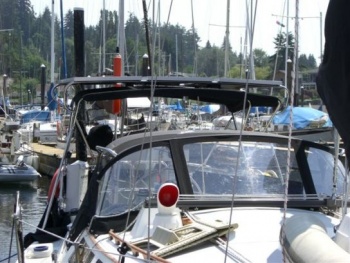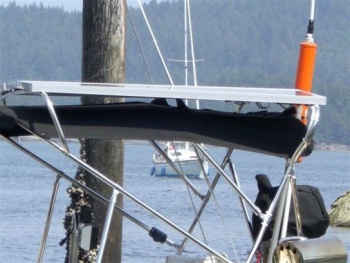Solar Power
400 Watt Bimini
by Steve Dolling BlackDragon #804
The frame is 1 inch stainless, 3 bows, with struts both fore and aft to provide the necessary support for the panels.
The bimini is now complete. 390 Watts of solar. By 8:00 in the morning it was serving the fridge load and putting 2A extra into the housebank. By noon it had completely replenished the 56 Ah deficit. I'm thinking I might run electric heaters through my inverter just because I can. It is really not as bulky as I thought it might be...
The solar panels have a pretty cool charge controller system. I wired the three panels in series. That gives 63 Volts going into the charge controller. Which is great. Big Volts means smaller Amps which means I didn't have to run massive wires to the charge controller. The charge controller actually does an inversion to AC and then converts back to DC. The idea is to always run the panels at the maximum power output while still giving the batteries the correct charge voltage. Disconnect the two and don't make charge voltage sunlight dependent or run the panels sub optimally. Supposed to be a really efficient way to go. It has full three stage charging plus a programmable equalization function.
And the part I really like is that it has a load shedding feature. There's a 20A circuit that shuts off if the battery drops below a threshold voltage and starts up when it's above another threshold. So it's possible to connect load like refrigeration to the load controlled circuit (this serves the load from the battery - it's independent of the panels - would work even if plugged into shore power.)
So we could leave refridgeration on and go exploring inland. In the worst case scenario, we come back to some smelly food but we won't have killed the house bank.
I'm going to bury my shore power cord in some deep, low, unreachable place.
Questions & Answers:
Q) Was the overall electrical design your own, or was it supplied by the manufacturer of the panels?
A) The panel manufacturers really only supplied the specifications. If you do some reading, you will likely be drawn to MPPT charge controllers. Outback and Bluesky are a couple of names that seem well regarded. I used a BlueSky 3024i. Believe it or not, connections to the controller and the settings for the controller are identical for 12V and 24V batteries and series or parallel installation. It really doesn't matter what you connect to it, the controller will figure it out. It is not a complex design. The biggest issue was sizing the system and I followed the same philosophy as my anchor design. You can't have too many electrons. I assumed doubling my current cruising load (tropics for the fridge, fans, watermaker) and did the math which crudely was as follows:
100 Amp hours per day @ 12V = 1200 Watt Hours / 8 hours of strong daylight = 150 Watts Capacity x 3 (the fudge factor) = 450 Watts
390 Watts met the asthetic criteria. The fudge factor allows for inefficiency (I am not going to adjust panels to face the sun and clean them every day) & extra load (because you never know). I don't have much data yet, but I think this was a very conservative design. No Honda generator will be in my aft locker.
Q) How did you fabricate the connections to the bimini frame?
A) I have two bars that support the panels mounted on a standard bimini frame. The bars bend around and have a nut welded in the end. Bolts pass throught the bimini frame and into the bars. The design allows for the bars to rotate forward or back so that I can make adjustments on the bimini and still level out the panel array. The panels themselves mount to the bars with straps bolted to the panel frame. I have neoprene pads so nothing rattles. The bar ends are nicely finished and have fittings that mate to the round surface of the bimini tubing.
Q) How easy would it be to remove the panels for maintenance/winter decommissioning?
A) 12 nuts. 3 electrical connections. Maybe 18 minutes.
Q) By having them in series, does this mean that if one panel fails the whole system is offline?
A) Yes! But don't let that dominate your decision criteria. Parallel installations are much more vulnerable to shading. A mast shadow across a panel could drop the voltage for entire installation below your charge threshold and give you zero output. That could happen daily. The likelihood of my system going down with a panel with a 20 year guarantee is small. If it did happen, I would have ten minutes of wiring work to do bypass the bad panel. (Following the 2 hours of diagnostic work to figure out what the problem was.) I wouldn't even consider wiring the panels in parallel.
Q) Did you reinforce the standard bimini frame in any way?
A) Yes. It's 1 inch tubing (common anyway). There are no straps. I have struts aft which lock it up both fore and aft and side to side. I have struts forward for extra support. There is some movement side to side at the forward part of the bimini if I push it. It may wobble on it's own in winds at 30 knots plus (didn't budge in 20 the other day). I will fabricate some blocks that will go around the backstay bridle and lock it up entirely.
Q) Any concern about the additional loads on the bimini frame when heeled in a blow?
(A couple of us in the club have discussed installing panels in this location, but assumed we would need some kind of reinforced arch.)
A) Yes. I used standard bimini type hardware and it still has set screws in the fittings. I don't like set screws in end fittings and plan to drill and through bolt before going down the coast. Once that is done, I will not be worried in anything up to 40 knots. And once it gets to 40 knots I'm going to have a whole bunch of other things on my mind other than my bimini, like how to gain leeway because every damn port down the coast has some unsafe bar in a breeze...


